WARAQA
Brief:
In this semester, we have completed the 2nd phase of a 3-stage project in the self-sufficiency studio. 1st phase was a cosmogram which is a visualization of all the researches and data we collected. As a result of the 1st phase, we designed the device, 2nd phase product, to implement our 3rd phase product which is a building.
Syrian Conflict
The war started officially on the 6th of March 2011, with 14 teenagers writing graffiti on the walls, who were then arrested. This sparked the beginning of the Syrian civil war.
This conflict has lasted 8 years and throughout this civil war, many of the country’s natural resources have been used or destroyed for political gain. From the seed bank that was moved to protect it from the conflict to the water that is being withheld and then released to create a flood. The oil and gas pipelines created a scenario where external governments felt the need to interfere to protect what they saw as assets.
Cosmogram
When we talk about cosmograms, we focused on the idea of creating objects or abstractions whose general and detailed reading helped us to fully understand the information and thus be able to draw objective conclusions from the clouds of information in their different variants.
Our cosmogram deals with the extruded separation of different layers of information whose connection generates an abstract and concise reading of the gaseous contamination of the different effects of conflict that occurred between 2011 and 2018 in the Syrian territory.
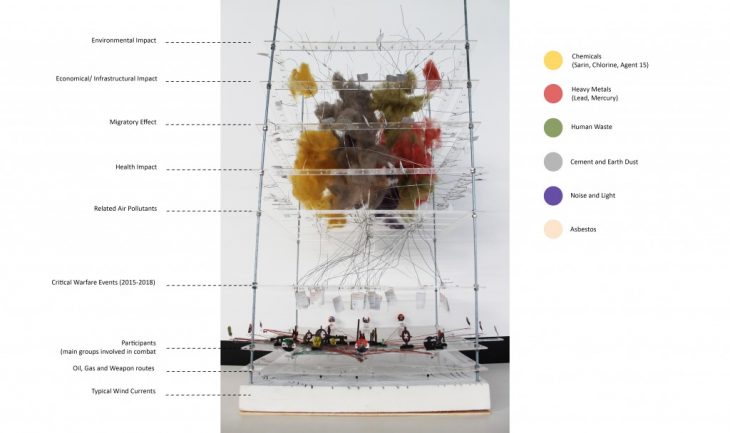
 To better understand the different layers of information, we investigated each layer in order to reach our final understanding. We started with the lower layer, the different wind current arrows that were generated are from the different seasons of the year are shown and which will help us to find the direction of the different gases in the atmosphere. Followed by this layer, there are gas and oil lines whose combination with the top layer of political confrontation, shows all the conflicts generated by the different countries and armed groups. This combination of both layers shows the catalog of different conflicts and is extruded to the next layer to begin to form the directions of the gases resulting from these conflicts.
To better understand the different layers of information, we investigated each layer in order to reach our final understanding. We started with the lower layer, the different wind current arrows that were generated are from the different seasons of the year are shown and which will help us to find the direction of the different gases in the atmosphere. Followed by this layer, there are gas and oil lines whose combination with the top layer of political confrontation, shows all the conflicts generated by the different countries and armed groups. This combination of both layers shows the catalog of different conflicts and is extruded to the next layer to begin to form the directions of the gases resulting from these conflicts.
Once these directions reach the top, they interlock with the resulting gas and in the upper layers, it is related to the different effective consequences that are: respiratory, migratory, economic and territorial. All these consequences connected with the gases resulting from the conflict make up a cloud of different colors, whose visual reading facilitates the atmospheric compression in which we focus.
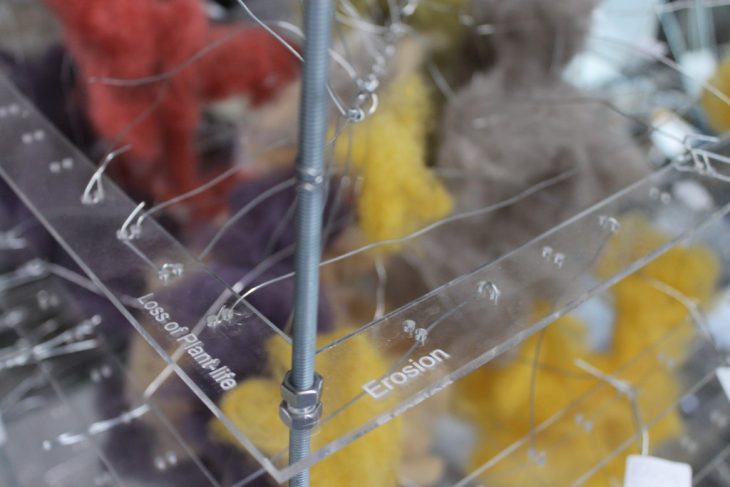


In conclusion, we see a great formation of gases in the Syrian atmosphere whose treatment has been null, but whose affections have been visibly recognized. All this global reading finally helps to understand the conflict in many ways, allowing a new way of approaching a project in this territory.
You can check here for more information about the cosmogram.
The Device
After the cosmogram, we decided to focus on dust, social division and ecology parts of the conflict.
Dust – What became clear through cosmogram research, is that while Chemical bomb clouds have an immediate devastating effect on the targeted area and its inhabitants, the particles settle from the air rather quickly. Whereas the debris from building destruction becomes a constant source of dust particles, circulating in the air. This issue is exacerbated by the drought conditions and the fertile soil disturbances from shelling. What’s most alarming is the lack of monitoring or analysis of what toxins are being emitted from these piles of waste.
It is clear there is a lack of data to prove the true impact of the weapon destruction in Syria, although it is obvious the issue exists. The climatic conditions of Syria already lean towards unfavorable atmospheric conditions.
Division – is the other concern, which our cosmogram exposes is the chaotic, confusing network of alliances and oppositions and the ensuing hostility and division of one nation. The social and cultural atmosphere is one of discord and disarray.
How can you begin to heal the cracks that have been driven between different groups of the larger Syrian society? Political differences will continue to exist, without a doubt. But what shared values and common interests can bring people together again, for a common cause that benefits all sides?
Ecology – We believe that the natural ecology of the environment is a critical factor in this complex scenario. Not only did the drought conditions exacerbate discontent, but the war itself is also threatening local species, and contaminating soil and water supply.
Syria is home to many valuable natural assets, which ought not to be lost.
For example, the seed bank of Syria, which contains over 155,000 varieties of the region’s main crops, is under threat, left abandoned in the middle of war-torn Aleppo city. Beekeepers around the country were forced to abandon hives in occupied land, losing their livelihood in the process. The guards of the near-extinct Syrian Bald Ibis colony near Palmyra were forced to flee.
Can we, through our device, support local livelihoods and promote a healthy post-war atmosphere, while protecting traditional craft and native assets?
As a result, we decided to create a device can touch all these concerns.
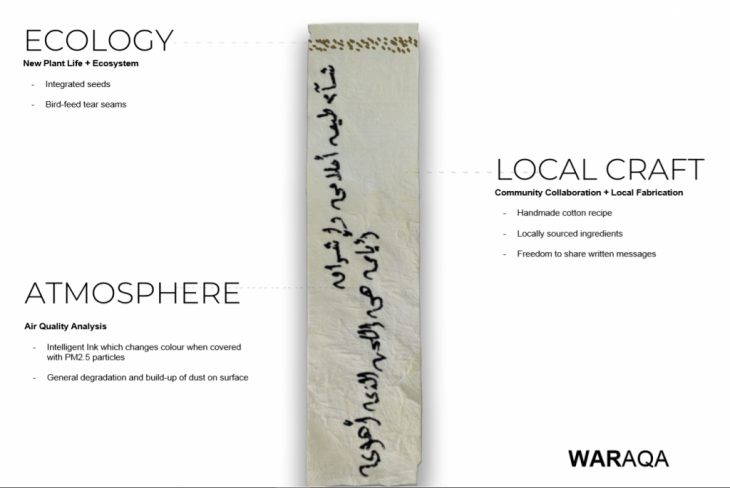
WARAQA – paper, as a device against the war.
This paper will be locally produced, by civilians, and combined with local wild-plant seeds. The paper will be a canvas for sharing messages in intelligent ink, which will visually indicate the presence of toxic particles in the air. Citizens can write whatever message they wish to share. And the collection of these papers, in a civic space, on a fixed structure, will offer a node of local scripture, a mini-ecosystem, and an air quality monitor.
– identify dust issue + community contribution/fabrication + wild plant growth
Paper Making Process
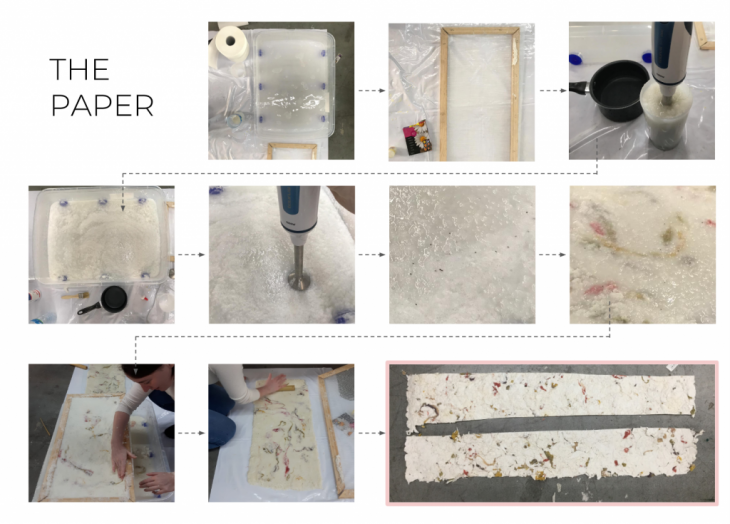
Intelligent Ink
Intelligent ink is very new technology, but in essence, when a prescribed chemical particle comes in contact with the ink surface, a reaction occurs which alters the color of the surface of the ink. For example, when the ink is exposed to sunlight or oxygen, it will change its state to blue – then when the ink becomes covered in a layer of dust, the dust will act as a barrier to oxygen or sunlight and the reaction will stop – thus returning the ink to its non-reactive state, ie. red.
This technology is currently being used in food packaging [modified atmosphere food packaging (MAP)], for oxidation or gas warnings, and also in self-cleaning glass, which reacts to organic matter.
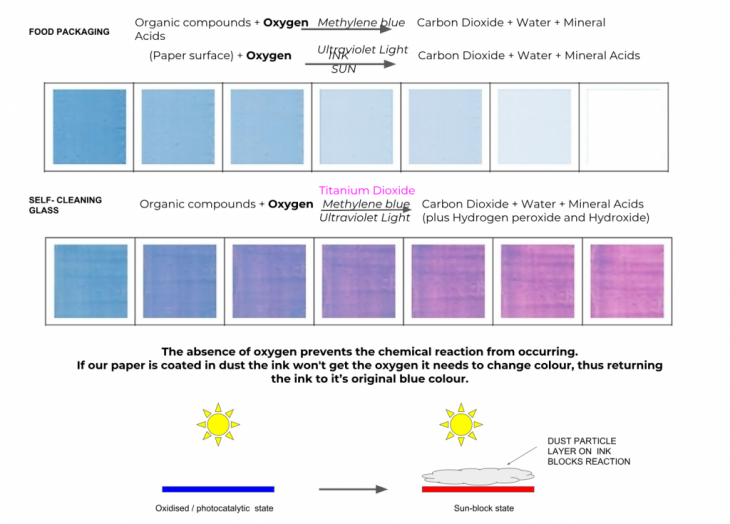
Device Structure
The structure which supports our paper devices will also be locally fabricated and therefore easy to construct using locally sourced material.
Here we use bamboo (which could be replaced by any sturdy long pole which can be drilled ), goats hair string, paper clips and Bees Wax (laced with seeds).
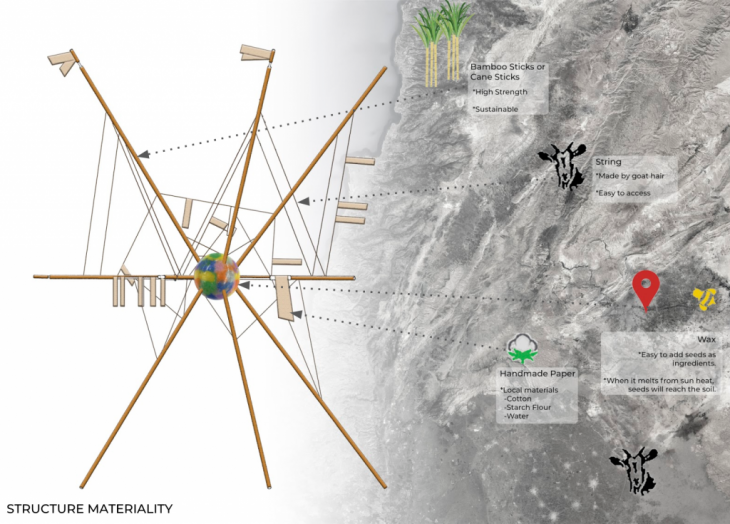
Interaction Diagram
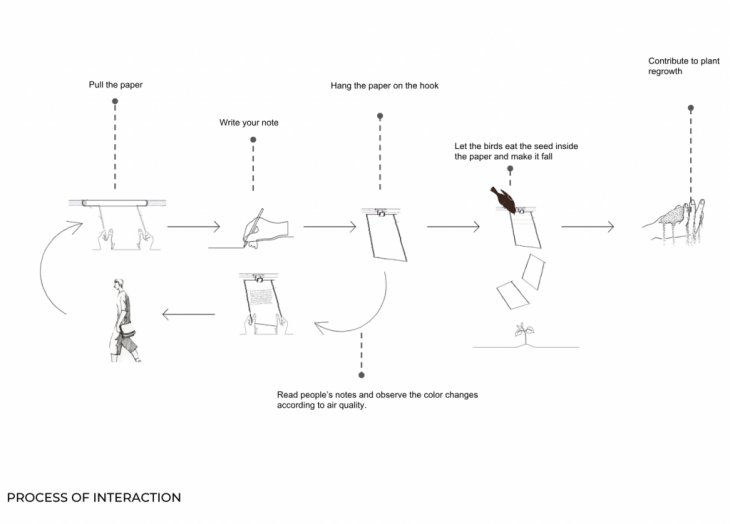
Timelapse
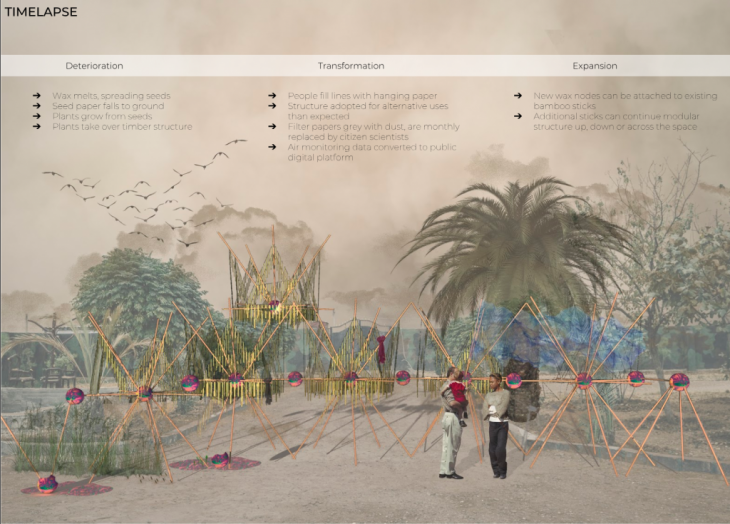
You can check here for more information about the device.
WARAQA is a project of IaaC, Institute for Advanced Architecture of Catalonia developed at Master in Advanced Architecture, in 2018/2019 by:
Students: Megan Yates Smylie, Jose Isidro Pastor Tormo, Holly Victoria Carton, Hena Micoogullari
Faculty: Enric Ruiz Geli, Josep Perello, Mieria Luzarraga, and Alejandro Muino
Support: Mohamad Rachid Jalloul and Francois Nour